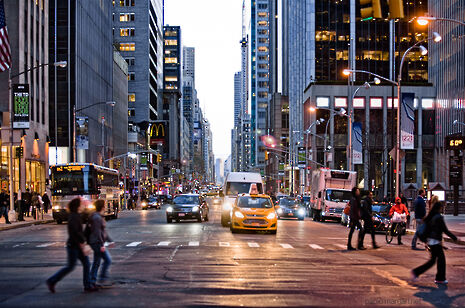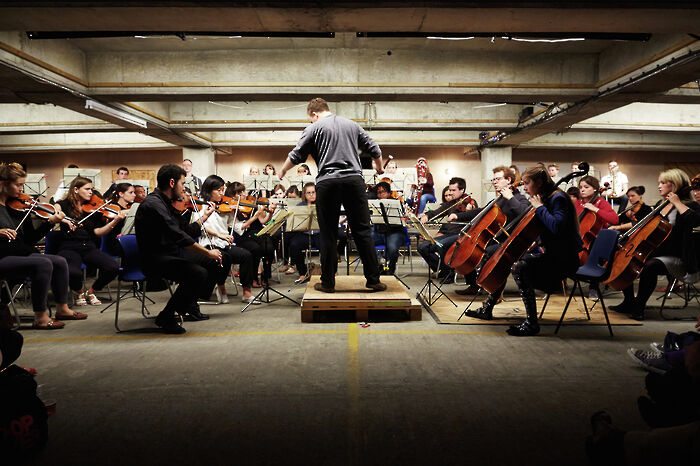New York, Paris, Baku: cities which have inspired composers
“Cities are constantly evolving, churning spaces of creativity, innovation and progress.” Thea Sands explores urban composition

The city is a constant source of inspiration for sound artists and composers, buzzing with iconic noises: crowds of people and objects bouncing from block to block in a unified soundtrack of the city, or as Frank Zappa called it, “sculpture in the air”, Cities are alive with the sound of music, pulsing, streaming, beating down streets, through clubs, festivals and bars. Composers of the 20th century realised this.
“Cities never fall silent, and will always be alive with the sound of music”
Modern music embraced technical innovation, using the urban sounds of horns, sirens and recording/sampling technologies to evoke the city. ‘Keynote sounds’ – the background noise of a sonic environment; ‘sound marks’ – sonic markers of a specific location (think of the mellifluous announcements of ‘mind the gap’ on the Tube ); and ‘sonic icons’ – sounds with no relationship to location but are woven into the sonic fabric of the place… like the vibrations of an accordion in Paris. Within the soundscape, we create our own private sonic environments by plugging in our iPods, filtering out background noise and thus renegotiating our associations with the city.
For Canadian composer and environmentalist Raymond Murray Schafer, repulsed by the gargling mass of consumer culture, soundscapes evoked nature beyond industrial society. He believed that city soundscapes had to contain ‘sonic grain’: pulsations and irregularities conveying the sense of passing time, something which the stationary drone of an air conditioner, for example, did not possess.
City Life, Steve Reich (1995)
Although influenced by the taxi horns in Gershwin’s An American in Paris, and Edgard Varèse’s use of sirens, American minimalist Reich used car horns, door slams, subway chimes, car alarms, heartbeats, fire and police sirens in his City Life, loaded onto a sampling keyboard and performed live. The music moves in phases, with the last movement using parts of field communications from the New York Fire Department during the 1993 bombing of the World Trade Centre.
Ionisation, Edgard Varèse (1931)
Similarly, Varèse’s (1883-1965) sound experiments stemmed from his sonic immersion whilst living in New York. He incorporated industrial noise into his music, attempting to “liberate Western classical music from the tyranny of conventional tuning systems, rhythms and timbres”. Ionisation was the first piece of Western classical music to be scored for entirely percussion, featuring cowbells, a whip and sirens – abandoning melody and harmony and focusing on texture, evoking the dismal chaos of cities.
The City Suite: 4 Small Pieces, Shane Myrbeck (2015)
Designed by Emily Shisko and Shane Myrbeck, the San Francisco Bay Area Planning and Urban Research Association’s 2015 exhibition Sound and the City featured The City Suite: 4 Small Pieces. Using four San Francisco-specific data sets – Development Pipeline: buildings in construction, Tides: sounds of tides on the bay with frequency illustrating the depth of water, Closed Venues: sampling sounds of music at the location of each closed venue, fading into the sounds of the city, and Wind: experienced through sonic pattern – the auditory experiment provided an immersion into the web of sounds that envelop the city, visually represented on a map of San Francisco’s neighbourhoods.
Symphony of Sirens, Arseni Avraamov (1922)
A monumental example of the collision of urbanisation, industry and music came from Arseni Avraamov’s (1886-1944) Symphony of Sirens. First staged in Baku in 1922, Avraamov activated the sounds of industry and the great metropolis: factory sirens, ship horns, artillery, full infantry regiments, trucks, seaplanes, twenty-five steam locomotives, pitched whistles and massive choirs of workers. Conducting the symphony himself from a specially built tower using signalling flags, he didn’t want spectators but wanted the active participation of everyone, all united in the ‘same revolutionary will’.
Quiet City, Aaron Copland (1941)
Aaron Copland’s (1900-1990) Quiet City captures the quintessential essence of an American city. Although less explicitly than Reich’s samples, the trumpet and Cor Anglais offer an ode to the metropolis of New York. With a spaciousness and improvisatory nature of the trumpet, this piece has been compared to the vastness of the American landscape and the mysteries beneath its surface.
Cage (1912-1992), the avant-garde, toyed with the acoustics of silence, notably in 4’33’’, comprising pure silence, celebrating contingent environmental sounds – a cough, cars rumbling past the concert hall, the slow decay of a slamming door – noise becomes music and audience becomes performer. As Cage wrote in 1937: “The Sound of a truck at fifty miles per hour. Static between the stations. Rain. We want to capture and control these sounds, to use them not as sound effects but as music.” Pierre Schaeffer (1910-1995) developed these ideas with his musique concrète. Using and distorting tape recordings of everyday sounds, he attempted to expand the space-time containers of compositions and concert halls into the world of sound around them. Churches and places of worship house these same principles, stretching time, where silence amplifies small incidental sounds and alters the sound world.
Just after Remembrance Sunday, it seems fitting to explore memorial silences. Silence transforms individual participants into universal beings. Sonic artist Jonty Semper’s Kenotaphion project explored the sonic structures of silence. He compiled every 11/11 Whitehall silence from 1929-2000, from the start of Big Ben’s chimes to the end of the silence, calling attention to the acoustic scene: the development of background noise, signals, birds, coughs, mutating into the roars of traffic as the decades pass.
Cities are constantly evolving, churning spaces of creativity, innovation and progress. The glass, bricks and steel that built these metropolitan machines create noise. People, objects, music and heartbeats of a city work together to create a distinct ever-changing acoustic sphere that inspires composers. Cities never fall silent, and will always be alive with the sound of music
 News / CUP announces funding scheme for under-represented academics19 December 2025
News / CUP announces funding scheme for under-represented academics19 December 2025 News / SU reluctantly registers controversial women’s soc18 December 2025
News / SU reluctantly registers controversial women’s soc18 December 2025 News / Cambridge welcomes UK rejoining the Erasmus scheme20 December 2025
News / Cambridge welcomes UK rejoining the Erasmus scheme20 December 2025 Features / Should I stay or should I go? Cambridge students and alumni reflect on how their memories stay with them15 December 2025
Features / Should I stay or should I go? Cambridge students and alumni reflect on how their memories stay with them15 December 2025 Film & TV / Timothée Chalamet and the era-fication of film marketing21 December 2025
Film & TV / Timothée Chalamet and the era-fication of film marketing21 December 2025










